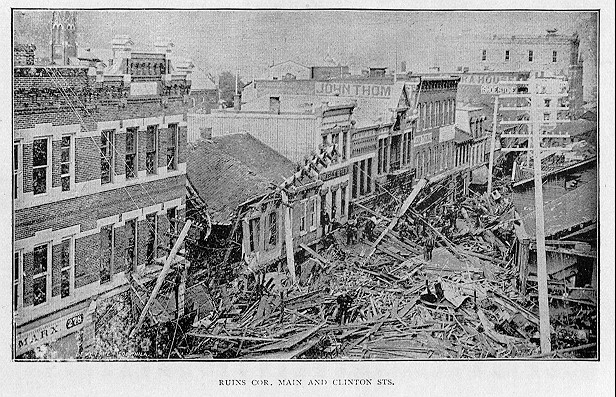
History of the Johnstown Flood
By Willis Fletcher Johnson
Chapter 13
|
IT was not "good morning" in Johnstown nor "good night" that passed as a salutation between neighbors who meet for the first time since the deluge, but "How many of your folks gone?" It is always "folks," always "gone." You heard it everywhere among the crowds that thronged the viaduct and looked down upon the ghastly twenty acres of unburied dead, from which dynamite was making a terrible exhumation of the corpses of two thousand mortals and five hundred houses. You heard it at the rope bridge, where the crowds waited the passage of the incessant file of empty coffins. You heard it upon the steep hillside beyond the valley of devastation, where the citizens of Johnstown had fled into the borough of Conemaugh for shelter. You heard it again, the first salutation, whenever a friend, who had been searching for his dead, met a neighbor: "Are any of your friends gone?" It was not said in tears or even seemingly in madness. It had simply come to be the "howd' ye-do" of the eleven thousand people who survived the twenty-nine thousand five hundred people of the valley of the Conemaugh. Still finding bodies by scores in the debris; still burying the dead and caring for the wounded; still feeding the famishing and housing the homeless, was the record for days following the one on which Johnstown was swept away. A perfect stream of wagons bearing the dead as fast as they were discovered was constantly filing to the various improvised morgues where the bodies were taken for identification. Hundreds of people were constantly crowding to these temporary houses, one of which was located in each of the suburban boroughs that surround Johnstown. Men armed with muskets uniformed sentinels, constituting the force that guarded the city while it was practically under martial law, stood at the doors and admitted the crowd by tens. In the central dead-house in Johnstown proper there lay two rows of ghastly dead. To the right were twenty bodies that had been identified. They were mostly women and children, and they were entirely covered with white sheets, and a piece of paper bearing the name was pinned at the feet. To the left were eighteen bodies of the unknown dead. As the people passed they were hurried along by an attendant and gazed at the uncovered faces seeking to identify them. All applicants for admission, if it was thought they were prompted by idle curiosity, were not allowed to enter. The central morgue was formerly a school-house, and the desks were used as biers for the dead bodies. Three of the former pupils lay on the desks dead, with white pieces of paper pinned on the white sheets that covered them, giving their names. But what touching scenes are enacted every hour about this mournful building! Outside the sharp voices of the sentinels are constantly shouting: "Move on." Inside weeping women and sad-faced, hollow-eyed men are bending over loved and familiar faces. Back on the steep grassy hill which rises abruptly on the other side of the street are crowds of curious people who have come in from the country round about to look at the wreckage strewn around where Johnstown was.
"Oh! Mr. Jones," a pale-faced woman asks, walking up, sobbing, "can't you tell me where we can get a coffin to bury Johnnie's body?" "Do you know," asks a tottering old man, as the pale-faced woman turns away, "whether they have found Jennie and the children?" "Jennie's body has just been found at the bridge," is the answer, "but the children can't be found." Jennie is the old man's widowed daughter, and was drowned, with her two children, while her husband was at work over at the Cambria Mills. Just a few doors below the school-house morgue is the central office of the "Registry Bureau." This was organized by Dr. Buchanan and H. G. Connaugh, for the purpose of having a registry made of all those who had escaped. They realized that it would be impossible to secure a complete list of dead, and that the only practicable thing was to get a complete list of the living. Then they would get all the Johnstown names, and by that means secure a list of the dead. That estimate will be based on figures secured by the subtraction of the total registry saved from total population of Johnstown and surrounding boroughs. "I have been around trying to find my sister-in-law, Mrs. Laura R. Jones, who is lost," said David L. Rogers. "How do you know she is lost?" he was asked. "Because I can't find her." When persons can't be found it is taken as conclusive evidence that they have been drowned. It is believed that the flood has buried a great many people below the bridge in the ground lying just below the Cambria Works. Here the rush of waters covered the railroad tracks ten feet deep with a coating of stones. Whether they will ever be dug for remains to be seen. Meantime, those who are easier to reach will be hunted for. There are many corpses in the area of rubbish that drifted down and lodged against the stone bridge of the Pennsylvania Railroad. Out of this rubbish one thousand bodies have already been taken. The fire that was started by the driftwood touching against the burning Catholic Church as it floated down was still burning. Walk almost anywhere through the devastated district and you will hear expressions like this: "Why, you see that pile of wreckage there. There are three bodies buried beneath that pile. I know them, for I lived next door. They are Mrs. Charles E. Kast and her daughter, who kept a tavern, and her bartender, C. S. Noble." Henry Rogers, of Pittsburg, is here caring for his relatives. "I am scarcely in a condition to talk," he says. "the awful scenes I have just witnessed and the troubles of my relatives have almost un-nerved me. My poor aunt, Mrs. William Slick, is now a raving maniac. Her husband was formerly the County Surveyor. He felt that the warning about the dam should not be disregarded. Accordingly he made preparations to go to a place of safety. His wife was just recovering from an illness, but he had to take her on horseback, and there was no time to get a carriage. They escaped, but all their property was washed away. Mrs. Slick for a time talked cheerfully enough, and said they should be thankful they had escaped with their lives. But on Sunday it was noticed that she was acting strangely. By night she was insane. I suppose the news that some relatives had perished was what turned her mind. I am much afraid that Mrs. Slick is not the only one in Johnstown whose reason has been dethroned by the calamity. I have talked with many citizens, and they certainly seem crazy to me. When the excitement passes off I suppose they will regain their reason. The escape of my uncle, George R. Slick, and his wife, I think was really providential. They, too, had determined to heed the warning that the dam was unsafe. When the flood came they had a carriage waiting at the front door. Just as they were entering it, the water came. How it was, my aunt cannot tell me, but they both managed to catch on to some debris, and were thus floated along. My aunt says she has an indistinct recollection of some one having helped her upon the roof of a house. The person who did her this service was lost. All night they floated along on the roof. They suffered greatly from exposure, as the weather was extremely chilly. Next morning they were fortunately landed safely. My uncle, however, is now lying at the point of death. I have noticed a singular coincidence here. Down in the lower end of the city stood the United Presbyterian parsonage. The waters carried it two miles and a half, and landed it in Sandy Vale Cemetery. Strange as it may seem, the sexton's house in the cemetery was swept away and landed near the foundations of the parsonage. I have seen this myself, and it is commented on by many others." In one place the roofs of forty frame houses were packed in together just as you would place forty bended cards one on top of another. The iron rods of a bridge were twisted into a perfect spiral six times around one of the girders. Just beneath it was a woman's trunk, broken up and half filled with sand, with silk dresses and a veil streaming out of it. From under the trunk men were lifting the body of its owner, perhaps, so burned, so horribly mutilated, so torn limb from limb that even the workmen, who have seen so many of these frightful sights that they have begun to get used to them, turned away sick at heart. In one place was a wrecked grocery store -- bins of coffee and tea, flour, spices and nuts, parts of the counter and the safe mingled together. Near it was the pantry of a house, still partly intact, the plates and saucers regularly piled up, a waiter and a teapot, but not a sign of the woodwork, not a recognizable outline of a house. In another place was a human foot, and crumbling indications of a boot, but no signs of a body. A hay-rick, half ashes, stood near the centre of the gorge. Workmen who dug about it to-day found a chicken coup, and in it two chickens, not only alive but clucking happily when they were released. A woman's hat, half burned; a reticule, with part of a hand still clinging to it; two shoes and part of a dress told the story of one unfortunate's death. Close at hand a commercial traveler had perished. There was his broken valise, still full of samples, fragments of his shoes, and some pieces of his clothing. Scenes like these were occurring all over the charred field where men were working with pick and axe and lifting out the poor, shattered remains of human beings, nearly always past recognition or identification, except by guess-work, or the locality where they were found. Articles of domestic use scattered through the rubbish helped to tell who some of the bodies were. Part of a set of dinner plates told one man where in the intangible mass his house was. In one place was a photograph album with one picture still recognizable. From this the body of a child near by was identified. A man who had spent a day and all night looking for the body of his wife, was directed to her remains by part of a trunk lid.
|
|
 |
 |
|
|
|
-
Site Navigation
 Home
Home What's New
What's New Bible
Bible Photos
Photos Hiking
Hiking E-Books
E-Books Genealogy
Genealogy Profile
Free Plug-ins You May Need
Profile
Free Plug-ins You May Need
 Get Java
Get Java.png) Get Flash
Get Flash Get 7-Zip
Get 7-Zip Get Acrobat Reader
Get Acrobat Reader Get TheWORD
Get TheWORD
